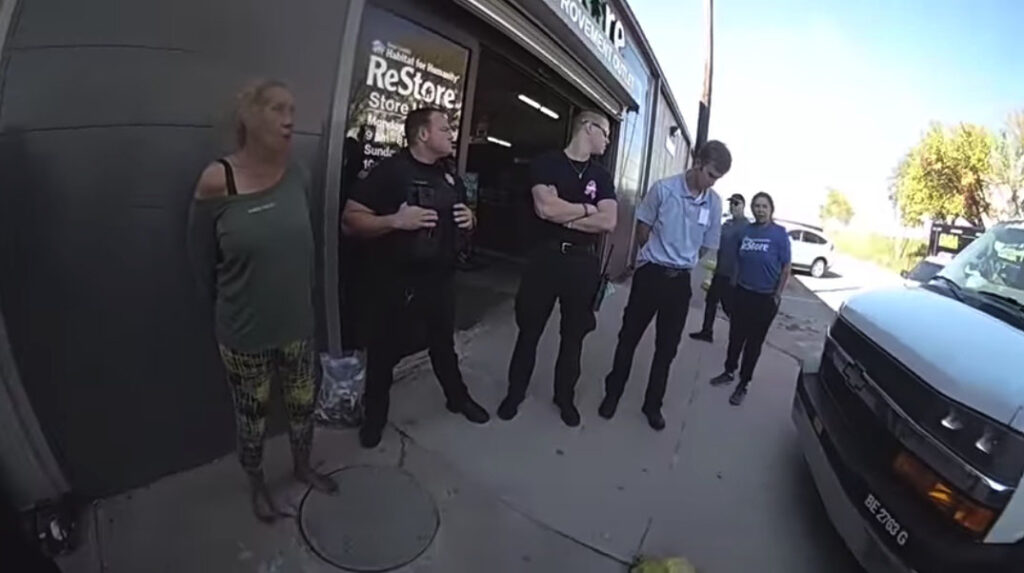By WHITNEY BRYEN, OKLAHOMA WATCH
LaDonna Paris was in the throes of a manic bipolar episode when Tulsa police kicked in the door of the bathroom where Paris had locked herself, knocked her to the ground and handcuffed her.
The 70-year-old great-grandmother, who kept repeating to herself that police wanted to kill her, was bleeding from an injury to her face resulting from the altercation that occurred on Oct. 25. Officers pulled Paris, who is Black, off the floor and escorted her from the store where she had taken refuge nearly four hours earlier.
A first responder who arrived at the store after Paris was dragged outside, told officers that he had seen her earlier that day and that she was in the throes of a manic bipolar episode. He said he tried to get her to go to the hospital that morning, but she refused.
Five months after Paris’ arrest, her son posted an edited version of body camera footage that he requested from police. The video, which has more than 63,000 views on YouTube, prompted public outcry over officers’ treatment of Paris.
Scenes depicting Officer Ronni Carrocia, who has been with the department for four years, taunting Paris before police forced their way into the bathroom drew the most outrage.

“Do you want to get tased?” Carrocia said as she leaned against the door firing her stun gun.
As Paris yells “don’t do it” from behind the locked door, Carrocia is seen laughing.
In response to public scrutiny, the department launched an internal investigation late last month and released a statement that said in part, “The overall actions of the Officers and the way in which the call was handled is within the policies of the Tulsa Police Department.”
An Oklahoma Watch review of Tulsa police policies, hours of body camera footage and interviews with law enforcement experts raise questions about the department’s stance and who these policies are protecting.
Policies outlining the department’s values, use of force and treatment of people suffering from mental illness conflict with footage of officers calling Paris names, threatening and bullying her, and belittling her mental state.
Paris escaped the encounter with minor physical injuries but interactions between people in crisis and police can have fatal consequences.
Oklahoma law enforcement have killed at least 53 people who exhibited signs of mental illness from 2013 to 2021, according to data from the Mapping Police Violence project. Eleven of those deaths occurred in Tulsa.
Lack of education can lead officers to misinterpret a situation or trigger someone who is reacting to past trauma.
Nearly one-third of Tulsa police have been trained in crisis intervention. None of the officers who responded to Paris had participated in the weeklong, voluntary training.
When incidents like this occur, the public can file complaints. Internal affairs can investigate and make recommendations. But the decision whether to discipline the officers and how lies with one man, Chief Wendell Franklin.
Advocates at some of the state’s largest mental health agencies are refusing to comment about the incident out of fear that scrutiny could make police less willing to work with them.
Rev. Marlin Lavanhar is Paris’ pastor and has known her for 15 years. He was among 20 residents who asked city council members to approve more law enforcement oversight in light of Paris’ treatment by officers.
“If that’s the policies of the Tulsa police then the policies need to change,” Lavanhar said. “If that’s OK then we know that the police can’t police themselves,” Marlin said, “and we need an office of independent monitor so that we can have somebody who is policing the police.”
Oklahoma Watch first contacted Franklin’s office for an interview on April 14. Staff in Franklin’s office said he did not have availability in his schedule for an interview the following week.
A department spokesman refused to comment on the incident citing the investigation.
Jeffery Pierce led Oklahoma City Police Department’s mental health unit. The retired captain said police shouldn’t be responding to mental health crises like this one. But until Oklahomans’ access to mental health care improves, departments need to train officers to handle these calls, he said, which includes fostering a culture of compassion and empathy.
While the officers who arrested Paris followed some protocols, Pierce said, other actions contradict Tulsa police policies.
Conduct
Page one of the department’s 543-page policy manual includes an oath that officers will perform their duties with integrity and the courage to respect the dignity and rights of every individual.
While filling out a report in her patrol car removing Paris from the bathroom, Carrocia tells another officer that Paris “should be at home crocheting for your grandkids you cuckoo bird.”
The department’s mental health policy, which was updated in 2016, states “Emotionally disturbed people will be treated courteously and humanely.”
Tulsa mental health coordinator Capt. Shellie Seibert authored the policy. She was a licensed mental health counselor before she joined the police force as an officer 23 years ago.
Seibert said the department stopped tracking mental health calls more than three years ago because the process was too time-consuming. Officers were responding to an average of 1,000 calls per month at the department’s last count, she said. Those calls have continued to increase, which means every officer is responding to mental health emergencies.
Of 1,105 hours of training at Tulsa’s Police Academy, 37 are dedicated to community and human relations. Of those 37 hours, 17 are spent teaching cadets about mental illness.
Seibert said officer Corracia’s attitude toward Paris highlighted a disconnect between what is being taught and how it’s being applied.
When asked how officers are expected to apply standards like courtesy and humanity on the job, department spokesman Capt. Richard Meulenberg did not have an answer. Instead, Meulenberg pointed to dictionary definitions of the words.
De-escalation
Three sentences encompass the department’s de-escalation policy.
“An officer shall use de-escalation techniques and other alternatives to higher levels of force consistent with his or her training whenever possible and appropriate before resorting to force and to reduce the need for force,” according to the policy.
The department’s statement called Carrocia’s comments “verbal coercion” and the rattling of the door an attempt “to get Paris to comply with the lawful order to come out.”
Pierce, who retired in January 2021, said the officers missed an opportunity to talk Paris out of the restroom by asking more questions about what Paris was experiencing and reassuring her instead of being antagonistic.
Under the department’s use of force policy, de-escalation is defined as “taking action or communicating verbally or non-verbally during a potential force encounter in an attempt to stabilize the situation and reduce the immediacy of the threat so that more time, options, and resources can be called upon to resolve the situation without the use of force or with a reduction in the force necessary.”
In training, officers learn and practice de-escalation nearly every day, said Earl Morrison, assistant director of the Council on Law Enforcement Education and Training. The agency provides basic training to law enforcement candidates across the state. Morrison said training is typically more intensive at academies run by police departments like Oklahoma City and Tulsa.
Cadets are taught to use soothing tones and to breath deeply in stressful situations to maintain their composure, Morrison said. Folded arms can seem defensive and interrupting, instead of listening, can cause frustration.
Officer Root, who was first on scene, asked Paris repeatedly to open the door but she refused. He asked why and she said “because I don’t trust you.” (Tulsa police refused to release Root’s first name and denied a April 4 request for the incident report.)
Root called for the department’s three-person community response team, which includes a mental health counselor. But the team was busy with another call. Other officers on duty who are trained in crisis intervention were also busy on other calls.
Officers also had an employee of the store call the manager, who Paris asked to speak with. Paris did not believe that the voice on speakerphone outside of the door was the manager.
“A big part of it is your mindset and your attitude,” Morrison said. “What people want more than anything is respect.”
Stun Guns
Along with firearms, handcuffs and pepper spray, many Tulsa officers carry conducted electrical weapons, or stun guns.
“A (conducted electrical weapon) is considered advanced force and should be handled with care,” according to department policy. “A (conducted electrical weapon) can be an ignition source and should not be deployed near flammable liquids and fumes…”
While she was locked in the bathroom, officers outside of the door could hear Paris spraying air freshener. Officers cited the aerosol spray and their belief that Paris had a lighter to justify kicking in the door and tackling Paris to the ground.
While standing directly in front of the door, officer Corracia said “she’s trying to set us on fire.”
Paris was arrested on seven charges, including arson, her attorney said during an interview with journalist Roland Martin.
A judge dismissed the charges.
Pierce said the officers did not act as though they were in danger.
“This is evidenced by the female officer continually standing directly in front of the door for most of the time depicted during the video segments,” Pierce said. “If danger were a real concern, I can’t imagine keeping that position if the officers truly believed weapons were involved.”
Pierce also pointed back to the department’s de-escalation policy which states, “Officers or employees shall not use tactics solely to justify the escalation of force when such escalation of force would not otherwise be appropriate (e.g., it would not be appropriate for personnel to step in the path of a moving vehicle solely to justify the use of great or deadly force as self-defense).”
Pierce said the officers showed little empathy for Paris though they knew she was suffering from mental illness. Officers repeatedly called Paris “85,” which is shorthand for 10-85, the code for a possible mental health situation.
“Although not an excuse, it is important to remember they are responding to a situation that has defaulted to them and police nationwide because of the continued failure of available and meaningful mental health treatment in the nation,” Pierce said.
If there was money for mental health crisis treatment, he said, there would be no need for police involvement except in the most extreme cases.
Whitney Bryen is an investigative reporter and visual storyteller at Oklahoma Watch with an emphasis on domestic violence, mental health and nursing homes affected by COVID-19. Contact her at (405) 201-6057 or wbryen@oklahomawatch.org. Follow her on Twitter @SoonerReporter.
FEATURED IMAGE
Tulsa police arrest a bloodied LaDonna Paris, who suffered facial cuts resulting from the altercation that occurred on Oct. 25, 2021. Officers pulled Paris, who is Black, off the floor and escorted her from the store where she had taken refuge nearly four hours earlier. TULSA POLICE BODY CAMERA











